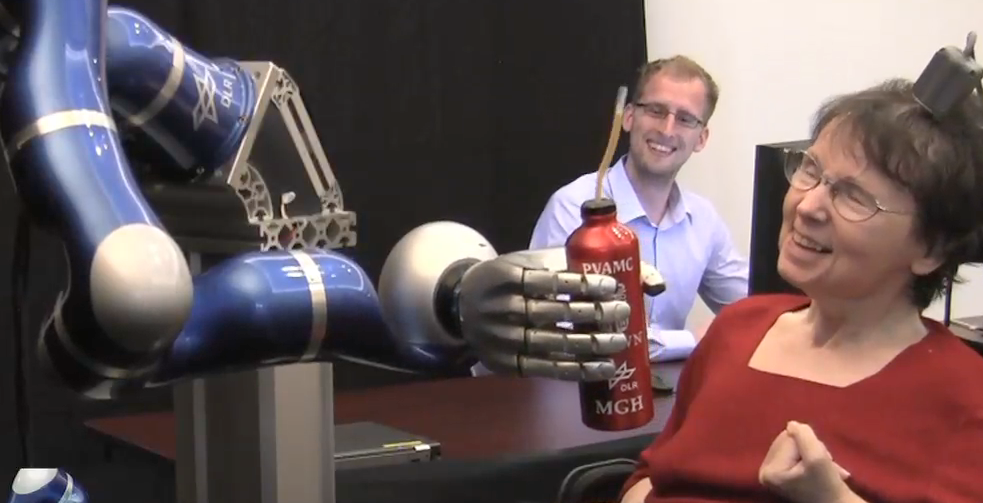Wireless brain sensor-transmitter could unchain neuroscience from cables
December 8, 2014

A look inside. The head-mounted, 100-channel transmitter is only 5 centimeters in its largest dimension and weighs only 46.1 grams, but can transmit data up to 200 megabits a second. (Credit: Nurmikko lab/Brown University)
A team of scientists led by Brown University has developed a high-data-rate, low-power, wireless brain-sensor and transmitter system for acquiring high-fidelity neural data during animal behavior experiments.
The new system solves a fundamental problem in neuroscience research: cables, which are needed to connect brain sensors to computers, constrain movement of subjects, limiting the kinds of research that are possible.
“We view this as a platform device for tapping into the richness of electrical signals from the brain among animal models, where their neural circuit activity reflects entirely volitional and naturalistic behavior, not constrained to particular space,” said Arto Nurmikko, professor of engineering and physics at the Brown Institute for Brain Science and the paper’s senior and corresponding author.
“This enables new types of neuroscience experiments with vast amounts of brain data wirelessly and continuously streamed from brain microcircuits.”
The custom-engineered neuroelectronic platform comprises two elements:
- A 100-channel transmitter that connects to a tiny implanted electrode array that detects the activity of scores of neurons in the cortex. It can run continuously for more than 48 hours on a single rechargeable AA battery
- A four-antenna receiver that uses sophisticated remote signal processing similar to that used in cellular phones to maximize the transmitter’s signal while the subject is moving around.

Current tethered brain-computer interfaces, as in this BrainGate neural interface system developed at Brown University, limit research to paralyzed subjects (credit: Brown University)
Natural environments
“The brain sensor is opening unprecedented opportunities for the development of neuroprosthetic treatments in natural and unconstrained environments,” said study co-author Grégoire Courtine, a professor at EPFL (École polytechnique fédérale de Lausanne), who collaborated with Nurmikko’s group on the research.
To confirm the system performance, the researchers did a series of experiments with rhesus macaques, which walked on a treadmill while the researchers used the wireless system to measure neural signals associated with the brain’s motion commands. They also did another experiment in which animal subjects went through sleep/wake cycles, unencumbered by cables or wires; the data showed distinct patterns related to the different stages of consciousness and the transitions between them.
“We hope that the wireless neurosensor will change the canonical paradigm of neuroscience research, enabling scientists to explore the nervous system within its natural context and without the use of tethering cables,” said co-lead author David Borton. “Subjects are free to roam, forage, sleep, etc., all while the researchers are observing the brain activity. We are very excited to see how the neuroscience community leverages this platform.”
Blackrock Microsystems LLC of Utah has licensed a portion of the technology from Brown University for commercial development. Scientists at EPFL, the Bordeaux Institute of Neuroscience, Motac Neuroscience, and the China Academy of Medical Sciences were also involved in the research, which was published in the journal Neuron. The U.S. National Institutes of Health, the National Science Foundation, the Defense Advanced Research Projects Agency, and the EU funded the research.
Abstract of Wireless Neurosensor for Full-Spectrum Electrophysiology Recordings during Free Behavior
Brain recordings in large animal models and humans typically rely on a tethered connection, which has restricted the spectrum of accessible experimental and clinical applications. To overcome this limitation, we have engineered a compact, lightweight, high data rate wireless neurosensor capable of recording the full spectrum of electrophysiological signals from the cortex of mobile subjects. The wireless communication system exploits a spatially distributed network of synchronized receivers that is scalable to hundreds of channels and vast environments. To demonstrate the versatility of our wireless neurosensor, we monitored cortical neuron populations in freely behaving nonhuman primates during natural locomotion and sleep-wake transitions in ecologically equivalent settings. The interface is electrically safe and compatible with the majority of existing neural probes, which may support previously inaccessible experimental and clinical research.